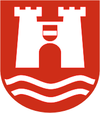| Dockings and Events |
|
| Museum Ship in Linz starts on 08.11. till 02.12.2012 |
 |
Our location: Obere Donaulände

Linz ( /ˈlɪnts/; German pronunciation: [ˈlɪnt͡s]) is the third-largest city of Austria and capital of the state of Upper Austria (German: Oberösterreich). It is located in the north centre of Austria,  approximately 30 km (19 mi) south of the Czech border, on both sides of the river Danube. The population of the city is 191,107, and that of the Greater Linz conurbation is about 271,000 approximately 30 km (19 mi) south of the Czech border, on both sides of the river Danube. The population of the city is 191,107, and that of the Greater Linz conurbation is about 271,000

History

The city was founded by the Romans, who called it Lentia.[2] The name Linz was first recorded in AD 799.
It was a provincial and local government city of the Holy Roman Empire, and an important trading point connecting several routes, on either side of the river Danube from the East to the West and Bohemia and Poland from north to the Balkans and Italy to the south. Being the city where the Habsburg Emperor Friedrich III spent his last years, it was, for a short period of time, the most important city in the empire.[3] It lost its status to Vienna and Prague after the death of the Emperor in 1493.
One important inhabitant of the city was Johannes Kepler, who spent several years of his life in the city teaching mathematics. He discovered, on 15 May 1618, the distance-cubed-over-time-squared — or 'third' — law of planetary motion. The local public university, Johannes Kepler University, is named after him.
Another famous citizen was Anton Bruckner, who spent the years between 1855 and 1868 working as a local composer and church organist in the city. The Brucknerhaus is named after him.
Adolf Hitler was born in the border town of Braunau am Inn but moved to Linz in his childhood. Hitler spent most of his youth in the Linz area, from 1898 until 1907, when he left for Vienna. The family lived first in the village of Leonding on the outskirts of town, and then on the Humboldtstrasse in Linz. After elementary education in Leonding, Hitler was enrolled in the Realschule (school) in Linz, as was the philosopher Ludwig Wittgenstein. Notorious Holocaust architect Adolf Eichmann also spent his youth in Linz. To the end of his life, Hitler considered Linz to be his "home town",[4] and envisioned extensive architectural schemes for it, wanting it to become the main cultural centre of the Third Reich.[5] In order to make the city economically vibrant, Hitler initiated a major industrialization of Linz shortly before, and during, World War II.
In addition to an ordnance depot, Linz has a benzol (oil)[1] plant which was bombed during the Oil Campaign on 16 October 1944. The Mauthausen-Gusen concentration camp is 20 kilometres (12 mile) east of the city of Linz.

Quelle: www.wikipedia.org

|
|
 |
|
| |
|
|
|

